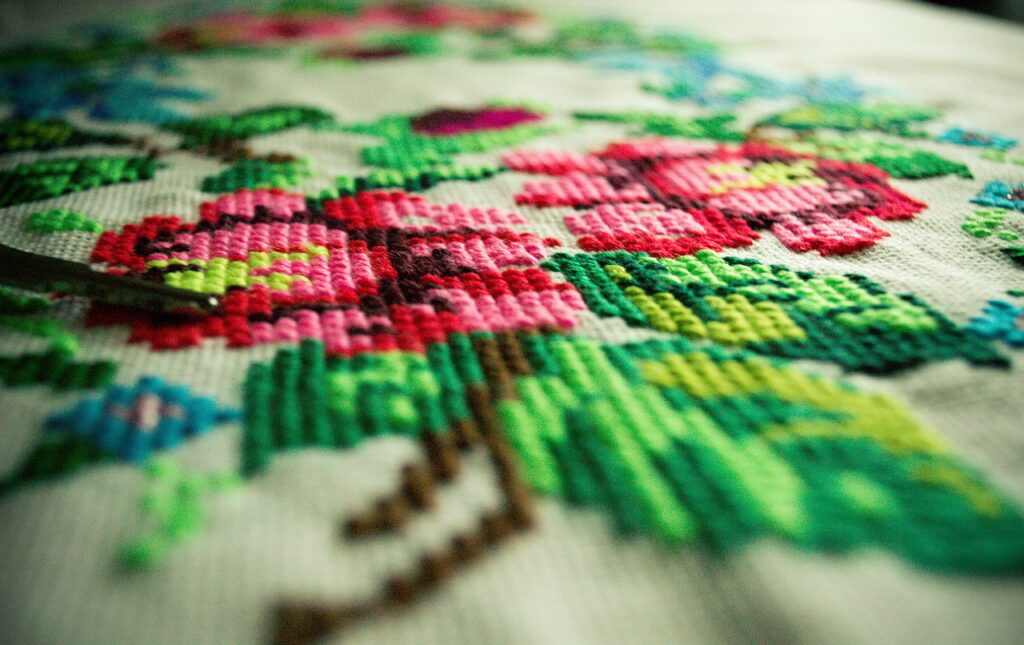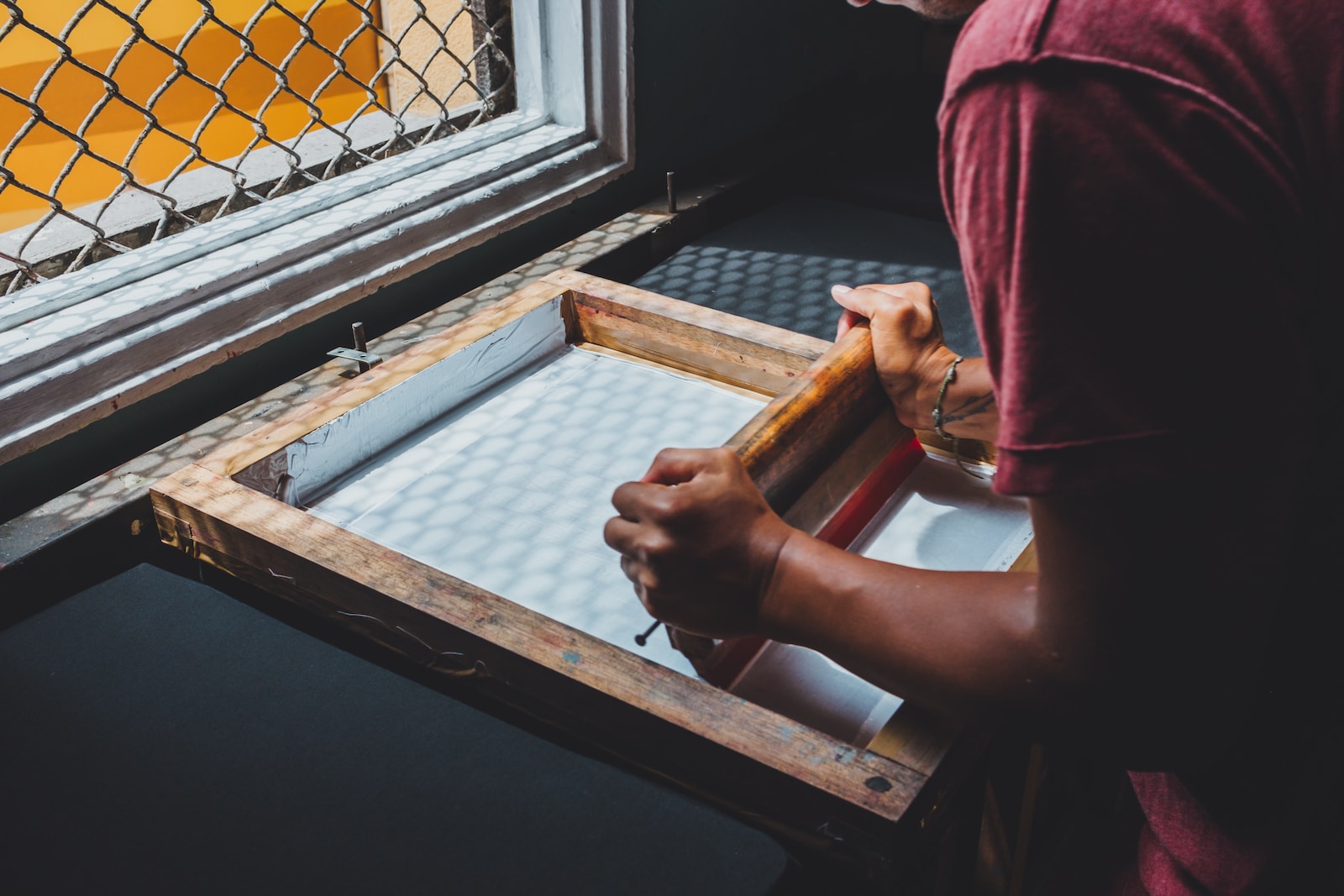Introduction
Embroidery and cross-stitch, two beloved needlework techniques, have been capturing the hearts of crafters and art enthusiasts for centuries. These traditional crafts not only showcase creativity but also provide a sense of accomplishment as each stitch comes together to form intricate designs. While both embroidery and cross-stitch involve stitching threads onto fabric, they possess distinct characteristics that set them apart.
Embroidery, with its origins dating back to ancient times, is an exquisite art form that encompasses various stitching techniques. It involves decorating fabric or other materials with needle and thread, creating beautiful patterns, motifs, and even pictures.
Embroidery offers a vast range of possibilities in terms of design complexity and materials used. One can create stunning masterpieces using stitches like the satin stitch for smooth coverage or the stem stitch for outlining shapes with precision.
From delicate floral motifs on clothing to intricate tapestries adorning royal chambers in history books, embroidery has always been celebrated as a versatile craft. Cross-stitch, on the other hand, is a specific type of counted-thread embroidery that involves making small “X” shaped stitches to form pixelated designs on even-weave fabric like Aida cloth or linen.
Its roots can be traced back to ancient Egypt and China but gained popularity during the Middle Ages in Europe as a way to adorn ecclesiastical garments. Cross-stitch patterns are typically created using grids or charts where symbols indicate different colored threads to be used on specific areas of the design.
With its repetitive nature and rhythmic stitching process, cross-stitch provides not only a creative outlet but also serves as an opportunity for relaxation and mindfulness. Despite their unique qualities, there has been an ongoing debate among artisans about which technique is faster when it comes to completing projects.
Some argue that embroidery allows for quicker progress due to its versatility in stitch choices and larger-scale designs achievable within shorter time frames. On the other hand, cross-stitch proponents argue that its grid-based patterns and repetitive nature enable crafters to work more efficiently and speedily.
In this article, we will delve deeper into this discussion, exploring the factors that influence the speed of completing both embroidery and cross-stitch projects. Let’s unravel the truth behind which needlework technique takes the lead in terms of swiftness without compromising the beauty of the final product.
Understanding Embroidery
Embroidery is an ancient art form that has been practiced for centuries. Its roots can be traced back to civilizations like the Egyptians, Greeks, and Chinese who adorned their garments with intricate needlework. Today, embroidery continues to captivate creative minds and serves as a beloved pastime for many.
One of the defining characteristics of embroidery is the use of various stitching techniques to create beautiful designs. There are numerous stitches in an embroiderer’s repertoire, each with its own unique effect.
One commonly used stitch is the satin stitch, which involves closely spaced parallel lines that create a smooth and solid fill. It’s perfect for creating bold shapes or backgrounds in your embroidery piece.
Another popular stitch is the stem stitch, known for its rope-like appearance and ability to create flowing lines and curves that resemble plant stems or tendrils. And let’s not forget the chain stitch—a simple yet versatile stitch that can be used for outlining or filling in larger areas.
What makes embroidery truly captivating is its versatility in terms of materials and designs. Embroiderers have a vast array of materials at their disposal—threads in different textures, colors, and thicknesses; beads; sequins; ribbons—the list goes on!
This allows them to experiment with different combinations and create visually stunning pieces. Furthermore, embroidery designs can range from traditional motifs like flowers and animals to modern abstract patterns or even personalized monograms.
The possibilities are endless, limited only by the embroiderer’s imagination. Embroidery truly embodies both craftsmanship and creativity.
Whether you’re embellishing clothing, home decor items, or creating intricate wall art pieces, embroidery offers a world of artistic expression waiting to be explored. (Note: Remember to continue with section 3 / 5 – Exploring Cross-Stitch)
Exploring Cross-Stitch
A Tale of Stitches and Threads
Cross-stitch, my dear readers, is a fascinating form of counted-thread embroidery that has stood the test of time. With its origins rooted in ancient Egypt and the Middle Ages, this craft has adorned textiles with intricate patterns for centuries.
What makes cross-stitch unique is its utilization of X-shaped stitches to form pictures and motifs. Imagine a canvas, be it fabric or even perforated paper, transformed into a colorful tapestry through the careful placement of these little crosses.
An Art Form Crafted on Graphs
To bring these captivating cross-stitch patterns to life, stitchers rely on grids or charts resembling blueprints. Each square on the graph represents an individual stitch within the design.
But it’s not just about blindly following predetermined lines—cross—stitch requires precision and attention to detail. Counting threads becomes an essential part of the process; by carefully determining how many threads to skip or stitch over in each direction, one can create clear and defined designs.
The choice of colors also plays a significant role in achieving the desired effect. Stitchers meticulously pick out shades from their collection of embroidery floss or thread based on the chart’s instructions.
A Meditative Dance
As we delve deeper into cross-stitch, we uncover its hidden charm—the repetitive nature that captivates so many enthusiasts around the world. Stitch by stitch, row by row, one loses themselves in a rhythmical dance between needle and thread.
This meditative quality offers solace from life’s chaos as concentration intensifies while creating complex patterns. The repetition itself becomes therapeutic—an opportunity for introspection and tranquility amidst an ever-busy world.
As each X-shaped stitch takes shape, stress dissipates like clouds parting after rainfall. Time slows down as hands gracefully guide the needle through the fabric, connecting with a timeless tradition that brings joy to both maker and admirer.
So, my dear readers, cross-stitch not only embodies a rich history but also invites us into a journey of focus and calm. Let us now turn our attention to the factors influencing its speed—a tale that promises further insights into this enchanting craft.
Factors Influencing Speed in Embroidery
Complexity and size of design/pattern chosen
When it comes to embroidery, the complexity and size of the design or pattern you choose can greatly influence the time it takes to complete a project. Intricate designs with multiple colors tend to require more time and attention to detail.
Each stitch must be meticulously executed, ensuring that the right color is used in the right place. These designs often involve a combination of different stitches, such as satin stitch, stem stitch, or chain stitch.
As a result, embroiderers need to invest extra effort and concentration into these intricate patterns. Furthermore, the size of your embroidery project can also impact completion time.
Larger projects naturally take longer to finish since they require more stitches and coverage area. Whether you’re working on a small handkerchief or a large wall hanging, keep in mind that larger designs demand additional time commitment and patience.
Skill level and experience of the embroiderer
An embroiderer’s skill level and experience play a significant role in determining how quickly they can complete a project. Beginners may need more time at first as they become familiar with various stitches and techniques. Learning new stitches requires practice and patience before achieving proficiency.
As beginners build their skills through trial and error, they gradually become faster at executing stitches accurately. On the other hand, experienced embroiderers benefit from muscle memory developed over years of practice.
They have honed their skills through countless hours spent stitching intricate patterns. With this acquired expertise, they can work swiftly without compromising on quality or precision.
Experienced artisans often employ efficient techniques that allow them to produce beautiful embroidery at an impressive speed. Remember that while speed is one aspect worth considering when comparing embroidery techniques with others like cross-stitching, it’s equally important to appreciate the artistry involved in creating unique embroidered pieces by hand.
Factors Influencing Speed in Cross-Stitch
The Dance of Complexity and Size
When it comes to cross-stitch, the complexity and size of the pattern chosen can greatly impact the speed at which you complete your project. Intricate patterns with fine details are a true labor of love that require time and patience.
As you meticulously follow each symbol on the chart, ensuring that every stitch aligns perfectly with its designated spot, you may find yourself lost in a world of meticulous artistry, moving at a slightly slower pace. Those tiny stitches may seem endless, but fear not!
With each completed section, you’ll witness your masterpiece taking shape. In addition to complexity, the size of your cross-stitch project plays a crucial role in determining how long it will take to complete.
Larger projects with higher stitch counts undoubtedly demand more time and dedication. As you embark on stitching an expansive landscape or a grand tapestry, be prepared for an immersive journey that might stretch over weeks or even months.
Remember though, patience is key! Embrace this opportunity to escape into the tranquil realm of cross-stitching as you watch your creation gradually come alive one stitch at a time.
Mastering Skills: From Novice to Master
Skill level and experience form another vital factor influencing how quickly you can finish your cross-stitch project. Beginners stepping into the world of cross-stitch may feel overwhelmed initially as they familiarize themselves with counting techniques and deciphering complex charts. Learning these foundational skills takes time and practice but fear not; perseverance will reward you handsomely!
On the other hand, seasoned cross-stitchers possess an invaluable advantage – experience. With every project completed, their nimble fingers become well-acquainted with deftly maneuvering through stitches.
Muscle memory kicks in like a trusted ally, allowing them to work faster without sacrificing precision. As they breeze through the rows and columns of their cross-stitch design, seasoned stitchers experience a harmonious flow that can only be attained through dedication and countless hours spent honing their craft.
Conclusion
In the enchanting world of cross-stitch, speed is relative, and each project has its own rhythm. While intricate patterns and larger projects may demand more time and patience, they offer a rewarding journey for those seeking an immersive creative experience. As beginners persist in mastering counting techniques, they too will find themselves stitching with increasing speed and confidence.
Ultimately, the art of cross-stitch is not just about completing a project quickly but rather about immersing oneself in the meditative joy of stitching as each colorful thread weaves together to create a stunning tapestry. So pick up your needle, embrace the dance between complexity and skill, and enjoy every stitch along this beautiful journey!
 Skip to main content
Skip to main content



